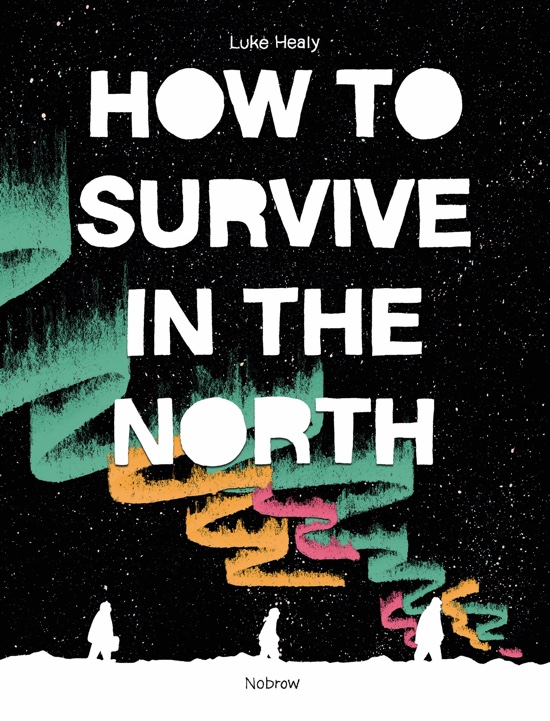As I write this intro, I’m just back from a couple of days at ELCAF. Kudos to organisers Nobrow for putting on such a fantastic showcase of the independent comics scene. The range of work on display was hugely impressive, and I returned home skint for the rest of the month but with some brilliant books, several by artists I’ve not read before.
One of the opportunities such events offer is the chance to see the output of a single imprint grouped together. I enjoyed the chance to speak to the team from Avery Hill, whose current lineup is particularly strong, as well as some of those they have published, such as Simon Moreton and Rachael Smith. Drawn to the Breakdown Press table, I spent a fair while chatting to Grumbling Fur member and friend of tQ Alexander Tucker about comics and music. Look out for a review of his new book World In The Forcefield 1 in the near future. There was a very strong aesthetic to all the work on Breakdown’s table, and I found myself buying a copy of Lando’s Gardens of Glass and wishing I’d had a bigger bag with me. Erstwhile stalwarts of the small press scene Throwaway Press (of Dirty Rotten Comics fame) had some terrific work on display, and seeing Nobrow’s catalogue piled on tables served as a reminder of just how much care they take with the outside of their books as well as the contents (and by the way, they have some great releases just out and coming soon too).
Permanently behatted Andy Oliver from Broken Frontier, whose recent anthology is reviewed below, was of course there. He’s also involved in Small Press Day 2016, an event taking place on 9th July in comic shops all over the country which looks well worth visiting if you get a chance. Finally, I briefly met Zainab Akhtar, who has just launched ShortBox, a curated collection of interesting comics that proved so popular that the first edition sold out in an hour. The UK scene is looking very healthy right now.
Luke Healy – How To Survive In The North
(Nobrow)
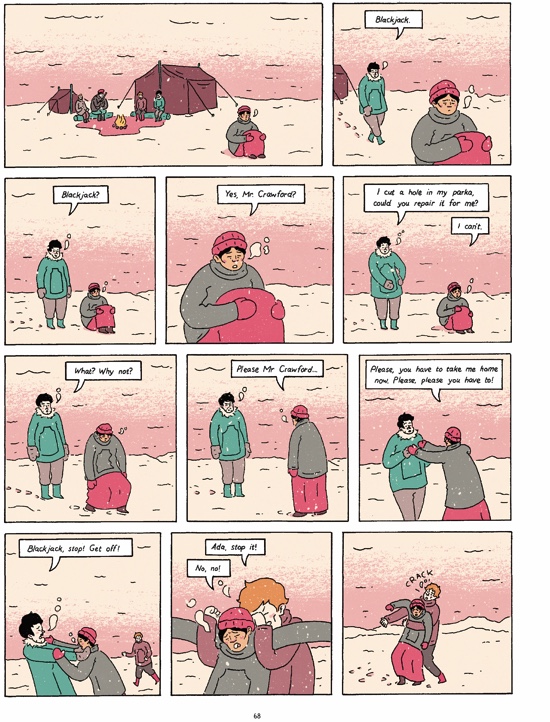
Luke Healy’s How To Survive In The North is an extremely accomplished debut graphic novel. Based on two related Artic expeditions, both of which were well documented at the time, it adds a contemporary fictional third strand. The expeditions were organised by Vilhjalmur Stefansson as an attempt to prove his theory of ‘the friendly Arctic’, his notion that as long as you knew how to get food and fuel from under the ice, it would be unproblematic to explore the area. The first expedition, in 1913, did not provide the confirmation he was looking for, although the polar bears seem to have found it easy enough to find food. The second, in 1921, is the tale of Ada Blackjack, an Inuk woman who accompanied the explorers as a seamstress to earn money for her tubercular son’s healthcare. The fictional strand set in 2013 concerns a disgraced college professor who starts to research Stefansson after discovering they had both occupied the same office.
Healy’s storytelling is superb. The book begins with a double page from each story, context free, before we travel back to the beginning of each. Gradually, connections emerge and the beautiful colouring does nothing to stem the slowly dawning horror as the conditions worsen. As the members of the 1921 expedition find themselves stuck on a deserted island, with crossing hundreds of miles of sea ice the only hope of escape, the discovery of bear skulls and the threat of scurvy reveal just how indifferent the friendly artic is to humans. There are numerous brilliantly understated details throughout, and the fact that we know Blackjack has a sick child at home makes her plight all the more awful. This is a book with a strongly compelling narrative – the expertly timed switches between the three stories encourage you to keep going – and I found myself reading the book in a single evening. The artwork is terrific, with really effective use of colour, and although the influence of Chris Ware can be seen in the characters it’s certainly not to the extent where it becomes derivative. Healy is a very talented storyteller and artist, and this is a strong release. Pete Redrup
Various – Broken Frontier Small Press Yearbook 2016
(Broken Frontier)
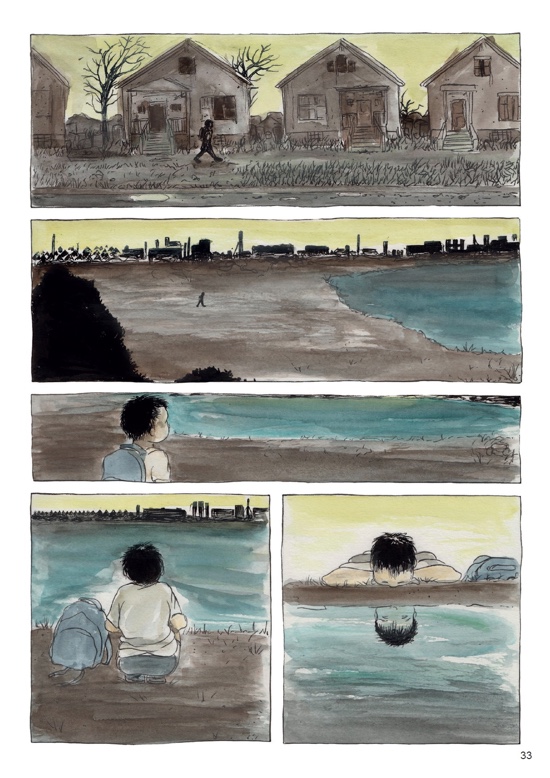
As noted above, It’s a good time to be a fan of UK small press comics. The Broken Frontier Small Press Yearbook 2016 is the brainchild of Andy Oliver, and fits into that category of both great and great value. A beautifully printed volume of over 80 pages, many in colour, it features some superb pieces. Organised around longer pieces from Broken Frontier’s list of ‘Six UK Small Press Creators to Watch in 2015’ – this is essentially their graduation show – it then follows up with 10 or so shorter pieces from more established artists.
There’s a consistently strong selection, with too many pieces to mention them all. Danny Noble’s Plain As The Nose On Your Face is brilliant, a ghost story wrapped up as a campfire tale and drawn in her instantly recognisable style. The chaotic layouts mixing and overlapping panels and unbordered drawings combined with her expressive faces work to create an engaging and very funny piece. It’s followed by Rozi Hathaway’s Afloat, a strikingly beautiful wordless tale of a child’s loneliness and imagination. Her art is terrific here, with wide panels working to place the child in small and large spaces, but always alone, with stunning colouring, sombre except for the sea and the sky. Adam Vian’s Court Of The Mapkeeper is next, in which much smaller panels and heavily stylised characters are used to tell the story of a feisty fortune teller. The second section of the book is also excellent, with a particularly funny Alex Potts strip amongst others.
At six quid, this is a no-brainer, and it left me with a list of artists I’m going to check out further. Andy Oliver has done a great service in putting this together, and the least you can do is buy a copy so that next year’s volume is a sure thing. Pete Redrup
Barbara Yelin – Irmina
(SelfMadeHero)
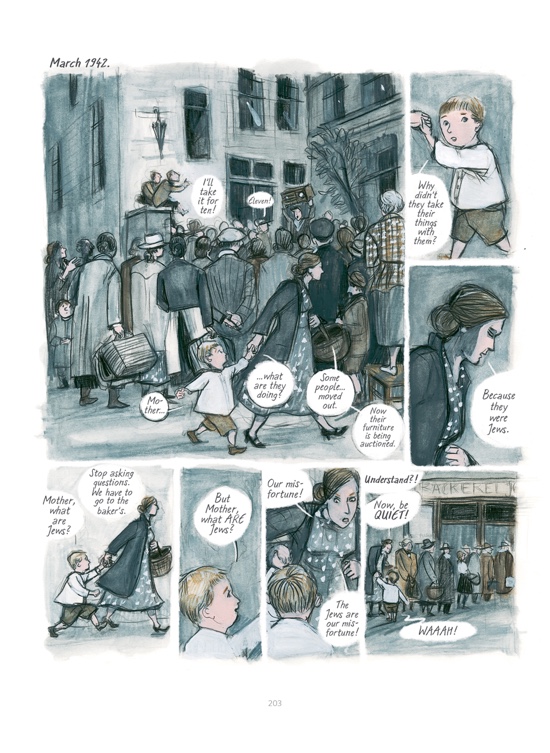
Irmina is a weighty book, in both form and theme. A beautiful hardcover up to SelfMadeHero’s usual high standards, it’s based on Barbara Yelin’s grandmother’s experiences living in Hitler’s Germany. Yelin’s introduction explains that she discovered a box of letters, and these left her wondering what turned her grandmother into someone who complicitly turned a blind eye to what was happening to the Jews.
The book starts in 1934 as Irmina arrives in London to study. We only hear of Germany through the English media, usually provoking a defensive response, but she is much more interested in what’s happening where she is, particularly in her relationship with Howard, one of the first black students at Oxford. As they become close, however, she is forced to return home, and the book switches to Berlin.
Now she works for a ministry in Berlin, where in contrast to her, most people are deeply patriotic and proud of Hitler. Her hopes of transfer back to London are gradually dashed, and having faced a constant financial struggle just to eat and stay warm, the lure of prosperity leads to marriage and a child. We see occasional glimpses of what is happening to the Jews when she ventures out of the apartment, but the holocaust is not addressed until Irmina’s young child starts asking questions. By now her heart is hardened against everyone, and her reply is to "Do what I do, Frieder, and look away”.
The third section, set in the 1980s, presents a more sympathetic character, but Yelin allows readers to decide how they feel about Irmina, and why she changed. The storytelling is compelling but not forceful, and this makes Irmina a more powerful title. There’s a sketchy quality to the pencilled artwork, and the mostly unbordered, variously shaped panels convey movement, pace and urgency, with sparing use of colour. This is a beautiful and thought-provoking book. Pete Redrup
Josh Simmons – Jessica Farm Vol 1 & 2
(Fantagraphics)
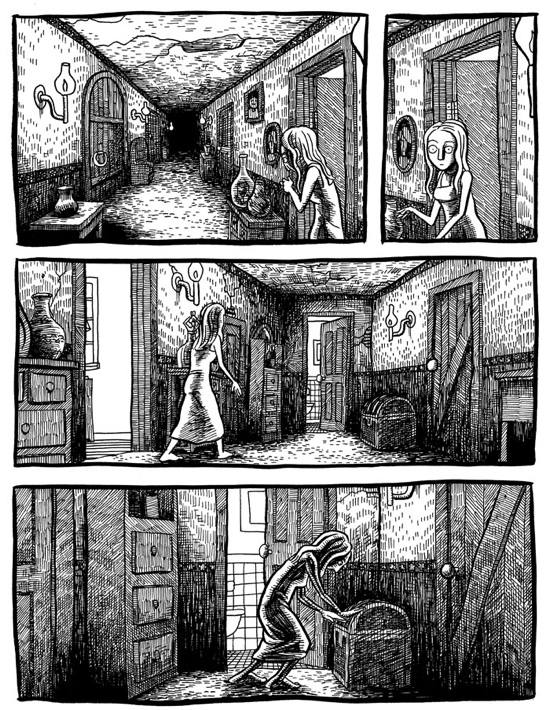
Jessica Farm is Josh Simmon’s ambitiously long term project – beginning in January 2000, he’s produced a page a month and intends to spend a total of 50 years on it. What we have here is therefore only a small part of the story. Volume 1 was published in 2008 and is reissued here alongside the second part, which together take us to just under 200 pages. And what pages. Jessica Farm lives on a farm, in a deeply bizarre house, much larger on the inside than the exterior suggests, like House of Leaves. She lives with her menacing father, and also many others, including countless tiny people. One nervously watches over her closet, while another leads a band who perform in the shower and give concerts in the attic. Not everyone is small, however – at one point a sinister man drags her into a room full of mutilated babies until she escapes, and we also encounter Captain, who seems to exist solely for Jessica’s sexual gratification.
This is all scene setting, however. When Jessica is attacked by a vicious monster and manages to escape, her grandparents send her on a mission, and the story heads in the direction of a fantasy quest, albeit a deeply transgressive, shockingly violent one. If Volume 1 is setup, Volume 2 is mostly a fight scene and chase, during which we learn that Jessica is the chosen one who will save the farm. The main battle is long enough that Simmons would have spent four years drawing it, densely packed pages full of hundreds of monsters drawn in his distinctive, slightly cartoony style. His shortest stories such as those in The Furry Trap often show fantastical worlds but without no explanation, just action. With longer pieces like House there’s much more detail but questions remain. Here, however, we are getting the chance to spend much more time in one of his worlds, and although there are few answers so far it does feel like they will come. These books are the sort you read very fast for the story, then again right away to slow down and savour the images. As ever, the interiors in particular captivate, darkly hatched and full of mysterious shadows. As you might expect for something produced over such a long time, however, there are some visual inconsistencies, with some of the pages of the fight being less well drawn.
An unfinished story is always less satisfying than a completed work, but there’s more than enough here to maintain interest until the next volume arrives in 2024. If you’ve enjoyed any of Josh Simmons’ work before, this won’t disappoint. Pete Redrup
Kelly Kwang – Frontier #12
(Youth in Decline)

This is my first encounter with Kelly Kwang’s art, and it’s unlike anything I’ve seen before – it took me a couple of reads through to get my bearings on it. There’s a hugely distinctive, consistent aesthetic at play here. This is apparently part of an ongoing series featuring her Space Youth Cadets, and functions as a meditation on internet culture amongst other things.
Many pages feature complex graphical user interfaces that bear some resemblance to Kai’s Power Tools, the famous set of Photoshop plugins from the 1990s, a world away from the clean, flat design favoured by the current generation of computing devices but much closer to those of games. Several pages bear more than a casual resemblance to the opening of an RPG where the player gets to customise the characteristics, appearance and accessories of their character before playing. There’s a cuteness to the images that is somewhat at odds with the numerous depictions of bladed weapons. Mostly in black and white, occasional hints of colour are to be found. Some pages are photographs of drawn images, prints, pins and fabric, making unusual use of 3D space and showing the breadth of Kwang’s expression of this aesthetic.
One page features the text “it’s funny how vast the face seems from such a close distance”, and that mirrors how I often felt about this issue – there are some pages that feel like you could dive into them and still never run out of details to find. This is not a narrative comic in any conventional sense, but more an artefact, frequently but not exclusively concerned with abstractions of a relationship between two cadets. As someone unfamiliar with the Space Youth Cadets, I’ve doubtless failed to appreciate many of the details here but even for a neophyte this is an engaging, genuinely unique and quite hypnotic book. Somewhere mid way through, a page features the text “Remember, it’s nice 2 have friends, choose yours wisely”. This issue of Frontier shows once again that Youth In Decline publisher Ryan Sands does exactly that. Pete Redrup
Matthew Swan – Parsley Girl
(Avery Hill)
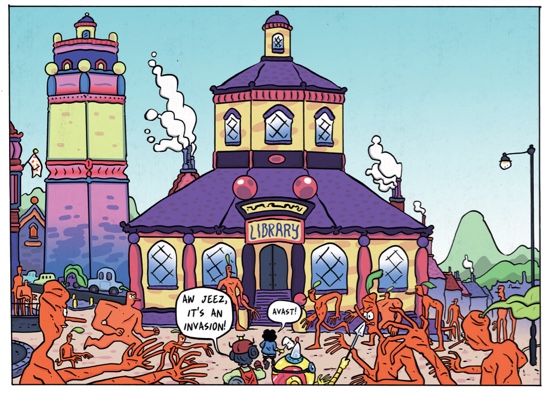
Visually, Parsley Girl is fantastic. The psychedelic designs are a feast of quirk and colour and the storytelling is both inventive and cohesive. The world Swan has created is populated with a great variety of weird and wonderful creatures, everyone a new colour and shape, although the possessed carrot monsters are of course all orange. And sort of, carroty. It’s not really clear what the eponymous heroine’s place in this world is, she and her two ‘pals’ (housemates? Family? Lovers?) have super powers, but I’m not sure whether this is the exception or the norm in the world of Parsley Girl, or what she has to do with Parsley other than being green. I would love to see the author develop this more in future issues as the world is an engaging one and the characters likeable and funny. The pages are peppered with little visual action jokes which work without being distracting, some referencing tropes of adventure and super hero genres, others delightfully bizarre in their own right. Highlights include a full page hieroglyphic coda handily portraying the spell needed to beat the bad guys, a Shaun of the Deadesque sequence of suburban mayhem, and a tall multi-coloured couple choosing potatoes in the vegetable aisle.
I have to say the pacing and narrative didn’t really grab me as much. The characters all seem well written and their dialogue is enjoyable, but the plot is a fairly flimsy framework for these things to be hung on and not enough pathos is built up for the characters or villagers. Although at times it seems this is an intentional joke, referencing genre conventions for poorly explained magic or science and evoking and subverting expected villain or helper roles, for me that is not reason enough to skip explanation that would help readers engage with the plot. Having read through the story once and flicking back through it for this review though, I do keep picking up on things that I love, so don’t let that stop you from buying this comic and feasting your eyes on the quirk and colour therein. Jenny Robins
Gareth A Hopkins – The Intercorstal 683
(Self Published)
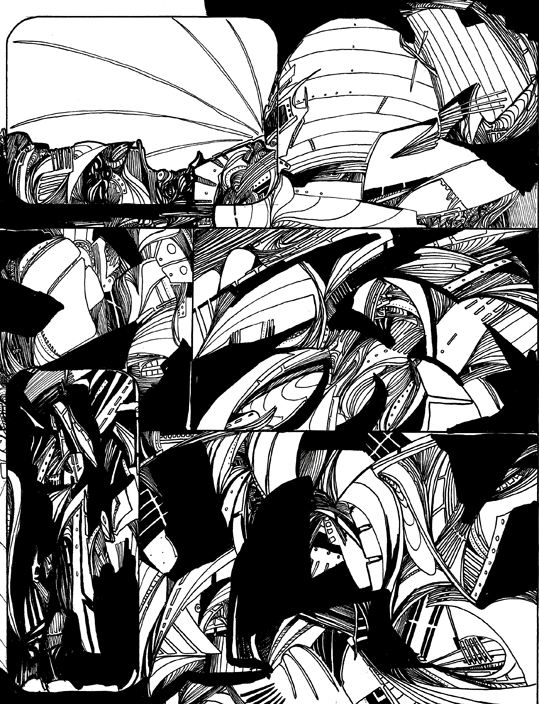
Having just complained in my last review of a lack of narrative, I’m not about to write a rave on a comic that has zero narrative, at least in the usual sense. With this latest and most official print incarnation of Gareth Hopkins’ ongoing abstract comics project of the last 8 years, you have the chance to really grapple with that question of the creation of tension and narrative drive in comics, beyond and in absence of not only dialogue, but any figurative visuals at all. Unlike many abstract comic artists however, whose imagery is often more akin to modernist painting wrestled into a grid format, Hopkins structural inspiration for this work is firmly rooted in the tricks and conventions of more traditional graphic storytelling, specifically in British anthology comics that the artist loved as a child (and still loves, presumably). In places ghostly hints of figures and objects are discernible in the abstract masses of line and tone, an effect which I find both arresting and slightly disappointing, as if the origins have not been cleverly enough masked in that panel.
Having a concrete jumping off point of composition and movement, these classic comics formats are transformed with The Intercorstal 683 into a series of different stylistic chapters. First the shapes writhe dramatically across the page, then a more melancholy and contemplative mood takes over only to be replaced in turn by sequences that are sinuous, then sparse, then cosmic and painterly. Distinct though each section is, they all pulse with an energy that combines what is most satisfying from both comic books and abstract art. I think this is a brilliantly pure expression of what post-modern creatives are capable of – calling simultaneously on the most indulgent and the most sublime in culture to forge a straightforward visual spectacle that communicates its rhythm in the most subtle of ways straight to the hindbrain of the teenage comics fan within the erudite art snob. Although the pages work as individual compositions, it is only bound into a book form that they really make sense. Jenny Robins
Manuele Fior – 5,000 km Per Second
(Fantagraphics)
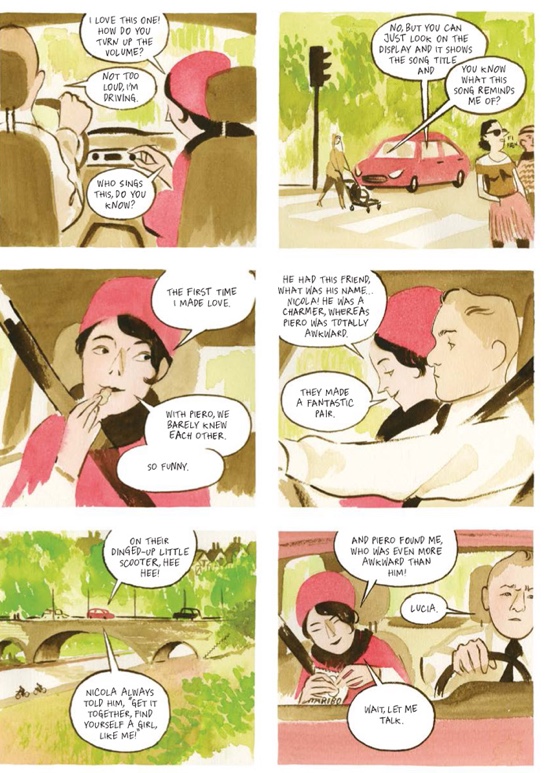
5,000 km Per Second is Manuele Fior’s first book to reach an English-speaking audience even though he has been creating graphic narratives for over a decade. Winner of the prestigious Golden Wildcat at Angoulême for best graphic novel in 2011, 5,000 km Per Second tells the story of an almost romance between Piero and Lucia, two Italians living abroad in Egypt and Norway respectively. The book begins with their adolescent infatuations in Italy, but before any sparks are allowed to fly we skip ahead to the post break-up melancholy, and the way in which these characters accept or deny the past.
Fior’s use of watercolour is a perfect choice of medium giving the characters a fluid and spontaneous sense of movement, while subtly depicting the emotional spectrum developed throughout the book. Youthful beginnings are painted in festive yellows, the heartaches of separation are painted in sickly blues and earth tones, the excitement of parenthood brings forth vibrant pinks and greens, and finally when the distant lovers reunite as middle-aged adults the art shifts into an emotional array of violet.
Every brush stroke is an integral part of the storytelling, not only depicting Piero and Luica’s attitudes towards each other, but also representing their displacement. The core of the book is obviously the unrequited love story, but as Piero and Lucia reminisce and settle into their new lifestyles we discover how the meaning of home changes for them.
Is home your place of birth or your place of residence? Does home travel with you like a piece of luggage, or is it something that gets left behind? Through Piero and Lucia’s story we learn that in a life often on the move, our definition of home can be as transient as our romances.
Manuele Fior belongs to a growing list of Italian creators available from Fantagraphics including Gabriella Giandelli, Lorenzo Mattotti, and Guido Crepax. Matthew Laiosa
Glen Baxter – Almost Completely Baxter
(New York Review Comics)
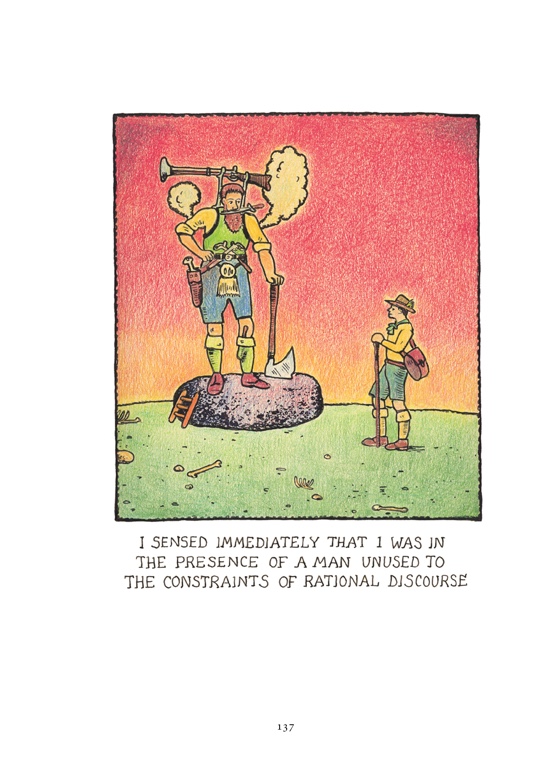
Glen Baxter is almost completely bonkers. Why almost? Because despite the absurdity of his cartoons his world is surprisingly logical. In order to sneak behind enemy lines why wouldn’t you retrofit a canoe with wheels and submerge it under water? His characters tend to take the road less travelled, or perhaps the road never travelled before, such as the Viking who invented the first yo-yo, but aren’t all visionaries seen as crackpots until their inventions meet our everyday needs?
I believe that if I ever met Glen Baxter the experience would be much like one of his cartoons featuring an uncomfortable encounter between a boy and an overly equipped hunter. The caption reads, ‘I sensed immediately that I was in the presence of a man unused to the constraints of rational discourse.’ At first glance, the axe, knives, pistols, blunderbuss, and smelly armpits are enough to deter anyone from conversing with the imposing individual, but when you examine more closely, and discover that the man uses a tiny ladder to climb a rock no taller than the average person’s kneecap, one’s only defence is to act as casual as possible while eyeballing the quickest escape route.
Glen Baxter is the grandmaster of the one-panel gag. Pulp adventurers in need of groceries, gangsters suffering from near-sightedness, and cowboys coming face-to-face with modern art are only a few of the absurd gems in this retrospective book. Matthew Laiosa

